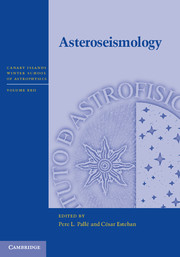Book contents
- Frontmatter
- Contents
- List of contributors
- List of participants
- Preface
- Acknowledgments
- Abbreviations
- 1 Sounding the solar cycle with helioseismology: Implications for asteroseismology
- 2 Learning physics from the stars: It's all in the coefficients
- 3 Solar-like oscillations: An observational perspective
- 4 Studying stars through frequency inversions
- 5 A crash course on data analysis in asteroseismology
- 6 An observer's views and tools
- 7 Asteroseismology of red giants
- References
7 - Asteroseismology of red giants
Published online by Cambridge University Press: 05 December 2013
- Frontmatter
- Contents
- List of contributors
- List of participants
- Preface
- Acknowledgments
- Abbreviations
- 1 Sounding the solar cycle with helioseismology: Implications for asteroseismology
- 2 Learning physics from the stars: It's all in the coefficients
- 3 Solar-like oscillations: An observational perspective
- 4 Studying stars through frequency inversions
- 5 A crash course on data analysis in asteroseismology
- 6 An observer's views and tools
- 7 Asteroseismology of red giants
- References
Summary
Introduction
Asteroseismology, and hence the study of stellar properties, is being revolutionized by the extremely accurate and extensive data from the CoRoT (Baglin et al., 2009) and Kepler (Borucki et al., 2009) space missions. Analysis of time series of unprecedented extent, continuity, and sensitivity has allowed the study of a broad range of stellar variability, including oscillations of a variety of pulsating stars (see, e.g., Gilliland et al., 2010; Christensen-Dalsgaard and Thompson, 2011, for reviews), and leading to comparative asteroseismology (or synasteroseismology) for main-sequence stars showing solar-like oscillation (Chaplin et al., 2011). Also, early analyses of Kepler data have demonstrated the power of asteroseismology in characterizing the central stars in planetary systems (Christensen-Dalsgaard et al., 2010; Batalha et al., 2011), and such investigations will undoubtedly play a major role in the continuing Kepler exploration of extrasolar planetary systems.
However, perhaps the most striking results of space asteroseismology have come from the investigation of red giants. Given the extensive outer convection zones of red giants, solar-like oscillations were predicted quite early (Christensen-Dalsgaard and Frandsen, 1983). Ground-based observations have been carried out in a few cases (e.g., Frandsen et al., 2002; De Ridder et al., 2006) but, owing to the very long periods of these huge stars, such observations are extremely demanding in terms of observing and observer's time. Space observations, on the other hand, allow nearly continuous observations over very extended periods, as demonstrated by early observations by the WIRE (Retter et al., 2003) and MOST (Barban et al., 2007) satellites.
- Type
- Chapter
- Information
- Asteroseismology , pp. 194 - 226Publisher: Cambridge University PressPrint publication year: 2014
References
- 11
- Cited by

